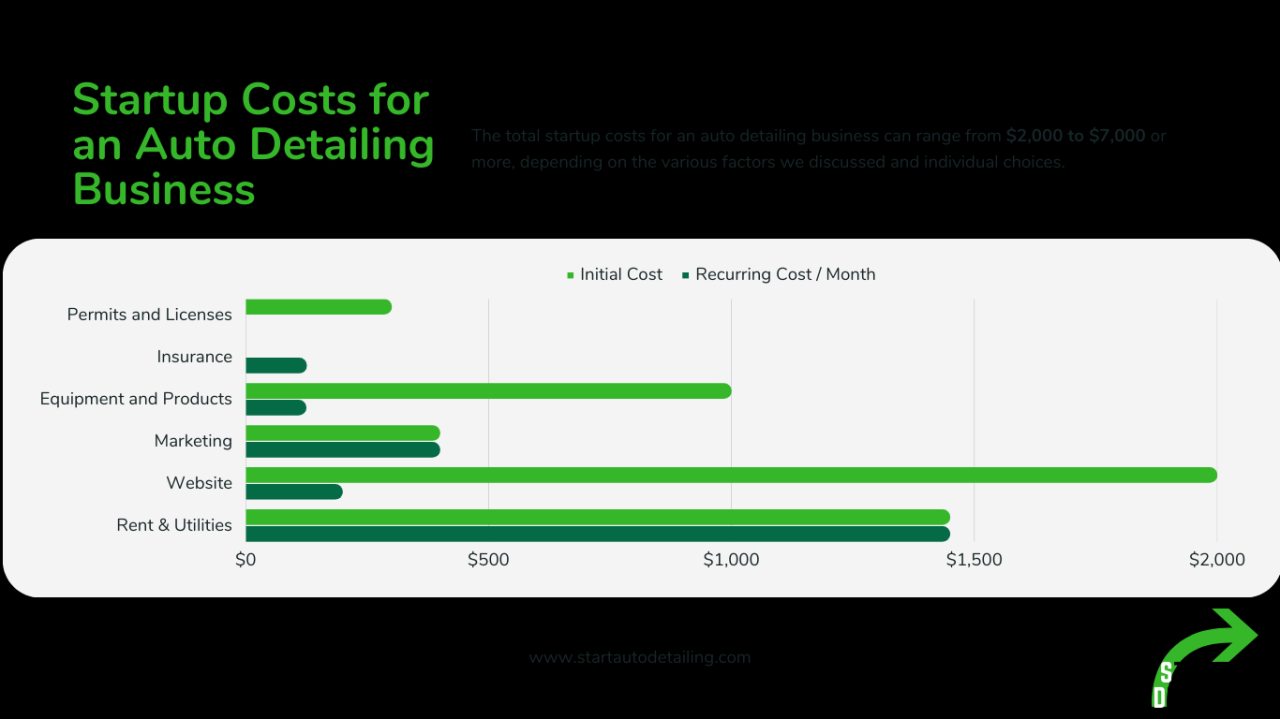How much does it cost to start a detailing business? This question is crucial for aspiring entrepreneurs eager to enter the lucrative world of car care. The initial investment can vary widely depending on your ambition and scale, encompassing everything from essential equipment and supplies to marketing and licensing. Understanding the financial landscape—from startup costs to ongoing expenses and pricing strategies—is vital for success. This guide breaks down the costs involved, helping you create a realistic budget and plan for profitability.
Launching a detailing business requires careful consideration of both immediate and long-term financial commitments. This includes assessing the cost of equipment (new versus used), securing a workspace (home-based versus commercial), and establishing a pricing structure that ensures profitability while remaining competitive. Beyond the initial investment, consistent monthly expenses like insurance, marketing, and supplies need to be factored into your financial projections. By understanding these elements, you can create a comprehensive business plan that sets you up for success in this detail-oriented industry.
Startup Costs

Starting a detailing business requires a careful assessment of initial investment costs. These costs can vary significantly depending on the scale of your operation, the quality of equipment you choose, and your location. Understanding these costs upfront is crucial for creating a realistic business plan and securing necessary funding.
Initial Investment Breakdown
The following table provides a sample breakdown of initial costs. Remember that these are estimates, and your actual costs may vary. Prices for equipment and supplies can fluctuate based on brand, retailer, and sales. Always shop around for the best deals.
| Item | Quantity | Unit Cost (USD) | Total Cost (USD) |
|---|---|---|---|
| Pressure Washer | 1 | 500 – 1500 | 500 – 1500 |
| Detailing Brushes & Applicators | Various | 50 – 150 | 50 – 150 |
| Vacuum Cleaner (Wet/Dry) | 1 | 200 – 500 | 200 – 500 |
| Microfiber Towels | 50 | 1 – 3 | 50 – 150 |
| Cleaning Solutions (All Purpose, Wheel Cleaner, etc.) | Various | 50 – 100 | 50 – 100 |
| Waxes & Polishes | Various | 75 – 200 | 75 – 200 |
| Detailing Kits (Interior/Exterior) | 1-2 | 100 – 300 | 100 – 600 |
| Business Licenses & Permits | 1 | 50 – 500 (varies by location) | 50 – 500 |
| Marketing Materials (Business Cards, Flyers) | Various | 50 – 100 | 50 – 100 |
| Initial Cleaning Supplies (Buckets, Spray Bottles) | Various | 25 – 50 | 25 – 50 |
Used vs. New Equipment
Purchasing used equipment offers a significant cost advantage. A used pressure washer, for example, might cost half the price of a new one. However, used equipment carries the risk of needing repairs sooner, potentially impacting your profitability. New equipment comes with warranties and often boasts better performance and longevity, although the upfront cost is substantially higher. The decision depends on your budget and risk tolerance. A smaller startup might opt for used equipment to minimize initial expenses, while a larger operation may prefer the reliability of new equipment.
Commercial Space vs. Home Operation
Operating from home significantly reduces overhead costs, eliminating rent and utilities associated with a commercial space. However, home-based operations may limit your capacity and professional image. Renting a commercial space provides a dedicated workspace, improves professionalism, and allows for expansion, but increases monthly expenses considerably. The choice depends on your business goals and financial resources. A home-based operation is ideal for a solo entrepreneur starting small, while a larger operation requiring more space and increased capacity would benefit from renting a commercial space.
Recurring Expenses

Successfully launching and maintaining a car detailing business requires careful financial planning. While initial startup costs are significant, ongoing monthly expenses play a crucial role in long-term profitability. Understanding and managing these recurring costs is vital for ensuring your business remains financially healthy and competitive. This section Artikels the key recurring expenses you should anticipate and provides strategies for effective budget management.
Monthly Budget Template
Creating a detailed monthly budget is essential for tracking expenses and identifying areas for potential savings. The following table provides a template to help you organize your recurring costs. Remember to adjust the estimated costs based on your specific location, business scale, and service offerings. Regularly reviewing and updating this budget is crucial for accurate financial planning.
| Expense Category | Estimated Cost | Frequency | Total Monthly Cost |
|---|---|---|---|
| Rent/Mortgage (Business Premises or Workspace) | $500 – $2000 | Monthly | $500 – $2000 |
| Utilities (Water, Electricity, Gas) | $100 – $300 | Monthly | $100 – $300 |
| Insurance (Liability, Property) | $150 – $300 | Monthly | $150 – $300 |
| Marketing/Advertising (Online ads, flyers, etc.) | $100 – $500 | Monthly | $100 – $500 |
| Cleaning Supplies (Soaps, waxes, towels) | $100 – $250 | Monthly | $100 – $250 |
| Vehicle Maintenance (Fuel, Repairs) | $100 – $300 | Monthly | $100 – $300 |
| Software/Subscription Fees (Scheduling, Accounting) | $50 – $150 | Monthly | $50 – $150 |
| Employee Wages (if applicable) | Variable | Monthly | Variable |
| Loan Payments (Business Loan) | Variable | Monthly | Variable |
Minimizing Recurring Expenses
Maintaining a high level of service doesn’t necessitate high recurring costs. Several strategies can help minimize expenses without compromising quality. Negotiating favorable rates with suppliers for cleaning supplies is one example. Exploring alternative marketing channels, such as social media marketing instead of costly print advertising, can also significantly reduce costs. Consider mobile detailing, eliminating the need for a fixed rent, or working from home to reduce overhead. Efficient scheduling and route planning can minimize fuel consumption.
Unexpected Repair and Replacement Fund
Equipment malfunctions and unexpected repairs are inevitable in any business. Setting aside a dedicated fund for these eventualities is crucial for preventing unexpected financial strain. This fund should cover the cost of repairing or replacing detailing equipment, such as pressure washers, vacuum cleaners, and polishing machines. A general rule of thumb is to allocate a percentage of your monthly revenue, perhaps 5-10%, to this contingency fund. This proactive approach ensures that your business can weather unforeseen challenges and maintain consistent service delivery. For example, a detailing business generating $5,000 in monthly revenue might allocate $250-$500 to this fund.
Pricing and Profitability
Profitability in the detailing business hinges on effective pricing strategies. Creating well-defined service packages that cater to different customer needs and budgets is crucial for maximizing revenue and ensuring a healthy profit margin. This section Artikels sample service packages, demonstrates profit margin calculation, and identifies key factors influencing pricing decisions.
Sample Detailing Service Packages
To illustrate effective pricing, three sample detailing packages are presented below. These packages offer varying levels of service to accommodate diverse customer preferences and budgets. Note that these prices are examples and should be adjusted based on your specific location, costs, and competitive landscape.
| Package Name | Services Included | Price |
|---|---|---|
| Basic Detail | Exterior wash and dry, tire shine, vacuuming of interior, window cleaning. | $75 |
| Premium Detail | All services included in Basic Detail, plus engine bay cleaning, interior detailing (leather conditioning, upholstery cleaning), and paint sealant. | $150 |
| Luxury Detail | All services included in Premium Detail, plus complete paint correction, ceramic coating, and interior detailing with steam cleaning. | $300 |
Profit Margin Calculation
Calculating profit margin involves subtracting total costs from revenue, then dividing the result by revenue. Let’s assume the following simplified cost structure for each package, considering both startup (amortized over a year) and recurring costs:
* Startup Costs (amortized): $5,000 per year (equipment, initial marketing, etc.) This is a simplified example; actual costs will vary.
* Recurring Costs (per detail): $10 (supplies, water, etc.) for Basic, $20 for Premium, and $30 for Luxury.
Basic Detail:
* Revenue: $75
* Total Costs: ($5000/year / 50 details per month * 12 months) + $10 = $20 + $10 = $30 (assuming 50 basic details per month)
* Profit: $75 – $30 = $45
* Profit Margin: ($45 / $75) * 100% = 60%
Premium Detail:
* Revenue: $150
* Total Costs: ($5000/year / 50 details per month * 12 months) + $20 = $20 + $20 = $40 (assuming 25 premium details per month)
* Profit: $150 – $40 = $110
* Profit Margin: ($110 / $150) * 100% = 73.33%
Luxury Detail:
* Revenue: $300
* Total Costs: ($5000/year / 50 details per month * 12 months) + $30 = $20 + $30 = $50 (assuming 10 luxury details per month)
* Profit: $300 – $50 = $250
* Profit Margin: ($250 / $300) * 100% = 83.33%
Profit Margin = (Revenue – Total Costs) / Revenue * 100%
Factors Influencing Pricing
Several factors significantly influence the pricing of detailing services. These include:
* Location: Higher rent and labor costs in urban areas typically justify higher prices compared to rural areas. A detail in Manhattan will likely command a higher price than one in a small town.
* Competition: Market analysis is essential. Researching competitor pricing helps establish a competitive yet profitable pricing structure. Undercutting drastically might affect perceived quality, while overpricing might limit customer acquisition.
* Level of Service: The complexity and quality of services directly impact pricing. A basic wash and vacuum will cost less than a full paint correction and ceramic coating. Using premium products will also justify higher prices.
Marketing and Customer Acquisition

Building a successful detailing business requires more than just exceptional cleaning skills; it necessitates a robust marketing strategy to attract and retain clients. Effective marketing will directly impact your profitability, ensuring a steady stream of customers and maximizing your return on investment. A multi-faceted approach, combining both online and offline tactics, is crucial for achieving consistent growth.
A comprehensive marketing plan should incorporate a mix of strategies to reach your target audience. This includes leveraging the power of digital marketing, building relationships within your community, and utilizing the often underestimated power of word-of-mouth referrals. The effectiveness of each strategy will depend on your specific target market and budget.
Marketing Strategies for Attracting Customers
Developing a strong marketing plan involves identifying your ideal customer and tailoring your message to resonate with them. The following strategies offer a diverse approach to reaching potential clients:
- Online Advertising: Utilize platforms like Google Ads and social media advertising (Facebook, Instagram) to target specific demographics and geographic locations interested in car detailing services. This allows for precise targeting and measurable results.
- Social Media Marketing: Create engaging content showcasing your work, highlighting customer testimonials, and running contests or giveaways to increase brand awareness and engagement on platforms like Instagram, Facebook, and TikTok. High-quality visuals are key.
- Local Partnerships: Collaborate with local businesses, such as car dealerships, auto repair shops, and even coffee shops, to offer cross-promotional opportunities. This expands your reach to a pre-qualified audience.
- Word-of-Mouth Referrals: Encourage satisfied customers to refer your services to their friends and family by offering incentives, such as discounts or loyalty programs. This leverages the power of personal recommendations.
- Website and Online Presence: Create a professional website with high-quality images of your work, a clear service menu, pricing information, and contact details. Ensure your business is listed on relevant online directories.
Cost and Return on Investment of Marketing Channels, How much does it cost to start a detailing business
The cost of different marketing channels varies significantly. Online advertising, for example, can range from a few hundred dollars per month for targeted social media campaigns to thousands for extensive Google Ads campaigns. The ROI depends heavily on the effectiveness of your ad copy, targeting, and the overall quality of your services. Local partnerships often involve bartering services or offering discounts, minimizing direct financial costs. Word-of-mouth marketing has a relatively low direct cost, but relies on excellent customer service and satisfaction.
For instance, a small-scale Google Ads campaign targeting a 10-mile radius might cost $300-$500 per month. If this generates 10 new clients at an average service price of $150, the ROI is substantial. Conversely, a poorly targeted campaign could yield minimal returns. Social media marketing costs can vary greatly depending on the platform and the level of advertising used. Organic social media marketing, focused on building a community, can be very cost-effective.
Sample Marketing Materials
A visually appealing marketing flyer or social media post is essential for capturing attention.
Sample Social Media Post (Instagram):
Image: A high-resolution before-and-after photo of a detailed car, showcasing the transformation. The car should be clean, shiny, and well-lit. The background should be uncluttered and visually appealing.
Caption: “Transform your ride! ✨ From dull to dazzling, we bring out the best in your vehicle. Book your detailing appointment today and experience the difference! Link in bio. #cardetailing #autodetailing #[yourcity]detailing #beforeandafter #shinycar”
Sample Marketing Flyer:
Visuals: The flyer should feature a striking image of a meticulously detailed car. Use high-quality photography, focusing on the shine and cleanliness. Include your logo prominently.
Message: The headline should be concise and attention-grabbing, such as “Sparkling Clean, Guaranteed!” or “Restore Your Car’s Glory.” Clearly list your services, pricing, and contact information. Include a special offer or discount to incentivize immediate action. The design should be clean, professional, and easy to read.
Legal and Insurance Considerations: How Much Does It Cost To Start A Detailing Business
Launching a mobile detailing business requires navigating legal and insurance requirements to protect both your assets and your clients. Failure to comply with these regulations can lead to significant financial and legal repercussions, hindering your business growth. Understanding and fulfilling these obligations is crucial for a successful and sustainable operation.
Necessary Licenses and Permits
Securing the appropriate licenses and permits is paramount for operating a legitimate detailing business. The specific requirements vary significantly depending on your location (city, county, and state), and sometimes even the type of services offered. It’s crucial to research your local regulations thoroughly. Failing to obtain necessary permits can result in hefty fines and even business closure.
- Business License: Most jurisdictions require a general business license to operate any type of business. This license typically involves registering your business name and obtaining an identification number.
- Seller’s Permit (or equivalent): If you’re selling products alongside your detailing services (e.g., waxes, cleaners), you’ll likely need a seller’s permit to collect and remit sales tax.
- Zoning Permits: Depending on your operating location (home-based, rented space, or mobile), you may need zoning permits to ensure your business complies with local land use regulations. Operating from a residential area may require specific permits and adherence to noise and traffic restrictions.
- Environmental Permits: Depending on the chemicals and waste generated, you might need permits related to waste disposal and environmental protection. This is particularly relevant if you’re using potentially hazardous materials.
- Vehicle Registration and Insurance: If you’re using a vehicle for your mobile detailing business, ensure you have the appropriate vehicle registration and insurance coverage.
Business Insurance
Adequate insurance is essential to protect your business from financial losses due to unforeseen events. Liability insurance is a critical component, covering potential damages or injuries caused during your detailing services. Workers’ compensation insurance is necessary if you employ others.
- General Liability Insurance: This covers bodily injury or property damage caused by your business operations. For example, if a client trips and falls on your work area, general liability insurance would help cover medical expenses and legal costs.
- Workers’ Compensation Insurance: If you hire employees, this insurance is crucial. It covers medical expenses and lost wages for employees injured on the job. Failure to carry workers’ compensation insurance can result in significant penalties if an employee is injured.
- Commercial Auto Insurance: If you use a vehicle for your business, you’ll need commercial auto insurance, which provides broader coverage than personal auto insurance, especially regarding business-related accidents.
Obtaining Licenses and Insurance
The process for obtaining licenses and insurance varies by location and provider. It generally involves completing applications, providing necessary documentation (such as business registration information and proof of address), and paying relevant fees. For insurance, you’ll need to provide information about your business operations and risk profile to obtain quotes from different insurers. It’s advisable to compare quotes from multiple insurers to find the most suitable and cost-effective coverage. For licenses, check your local government websites or contact your city/county clerk’s office for specific instructions and application forms. For insurance, contact insurance brokers or agents specializing in small business insurance.






